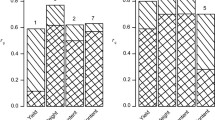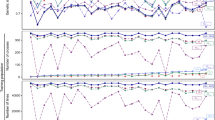Abstract
The availability of cheap and abundant molecular markers has led to plant-breeding methods that rely on the prediction of genotypic value from marker data, but published information is lacking on the accuracy of genotypic value predictions with empirical data in plants. Our objectives were to (1) determine the accuracy of genotypic value predictions from multiple linear regression (MLR) and genomewide selection via best linear unbiased prediction (BLUP) in biparental plant populations; (2) assess the accuracy of predictions for different numbers of markers (N M) and progenies (N P) used in estimation; and (3) determine if an empirical Bayes approach for modeling of the variances of individual markers and of epistatic effects leads to more accurate predictions in empirical data. We divided each of four maize (Zea mays L.) datasets, one Arabidopsis dataset, and two barley (Hordeum vulgare L.) datasets into an estimation set, where marker effects were calculated, and a test set, where genotypic values were predicted based on markers. Predictions were more accurate with BLUP than with MLR. Predictions became more accurate as N P and N M increased, until sufficient genome coverage was reached. Modeling marker variances with the empirical Bayes method sometimes led to slightly better predictions, but the accuracy with different variants of the empirical Bayes method was often inconsistent. In nearly all cases, the accuracy with BLUP was not significantly different from the highest accuracy across all methods. Accounting for epistasis in the empirical Bayes procedure led to poorer predictions. We concluded that among the methods considered, the quick and simple BLUP approach is the method of choice for predicting genotypic value in biparental plant populations.

Similar content being viewed by others
References
Beavis WD (1994) The power and deceit of QTL experiments: lessons from comparative QTL studies. In: Proceedings of the corn sorghum industrial research conference, 7–8 Dec 1994, Chicago, IL. Am Seed Trade Assoc, Washington DC
Bernardo R (1991) Retrospective index weights used in multiple trait selection in a maize breeding program. Crop Sci 31:1174–1179
Bernardo R (2008) Molecular markers and selection for complex traits in plants: learning from the last 20 years. Crop Sci 48:1649–1664
Bernardo R, Yu J (2007) Prospects for genomewide selection for quantitative traits in maize. Crop Sci 47:1082–1090
Bernardo R, Moreau L, Charcosset A (2006) Number and fitness of selected individuals in marker-assisted and phenotypic recurrent selection. Crop Sci 46:1972–1980
Broman KW, Wu H, Sen S, Churchill GA (2003) R/qtl: QTL mapping in experimental crosses. Bioinformatics 19:889–890
Calus MPL, Meuwissen THE, de Roos APW, Veerkamp RF (2008) Accuracy of genomic selection using different methods to define haplotypes. Genetics 178:553–561
Chao S, Anderson J, Glover K, Smith K (2006) Use of high throughput marker technologies for marker-assisted breeding in wheat and barley. In: Proceedings of plant and animal genome XIV conference, 14–18 Jan 2006, San Diego, CA
Dekkers JCM (2007) Prediction of response to marker-assisted and genomic selection using selection index theory. J Anim Breed Genet 124:331–341
Doerge RW (2002) Mapping and analysis of quantitative trait loci in experimental populations. Nat Rev Genet 3:43–52
Dudley JW (2008) Epistatic interactions in crosses of Illinois high oil x Illinois low oil and of Illinois high protein x Illinois low protein corn strains. Crop Sci 48:59–68
Dudley JW, Johnson GR (2009) Epistatic models improve prediction of performance in corn. Crop Sci 49:763–770
Eathington SR, Crosbie TM, Edwards MD, Reiter RS, Bull JK (2007) Molecular markers in a commercial breeding program. Crop Sci 47(S3):S154–S163
Edwards M, Johnson L (1994) RFLPs for rapid recurrent selection. p. 33-40. In Analysis of molecular marker data. Joint Plant Breeding Symposia Series. ASA, Madison, WI
Gianola D, Perez-Enciso M, Toro MA (2003) On marker-assisted prediction of genetic value: beyond the ridge. Genetics 163:347–365
Goddard ME, Hayes BJ (2007) Genomic selection. J Anim Breed Genet 124:323–330
Hayes PM, Liu BH, Knapp SJ, Chen F, Jones B, Blake T, Franckowiak J, Rasmusson D, Sorrels M, Ullrich SE, Wesenberg D, Kleinhofs A (1993) Quantitative trait locus effects and environmental interaction in a sample of North American barley germplasm. Theor Appl Genet 87:392–401
Hayes BJ, Chamberlain AJ, McPartlan H, Macleod I, Sethuraman L, Goddard ME (2007) Accuracy of marker-assisted selection with single markers and marker haplotypes in cattle. Genet Res Camb 89:215–220
Henderson CR (1984) Applications of linear models in animal breeding. Univ of Guelph, ON
Holland JB (2007) Genetic architecture of complex traits in plants. Curr Opin Plant Biol 10:156–161
Hospital F, Moreau L, Lacoudre F, Charcosset A, Gallais A (1997) More on the efficiency of marker-assisted selection. Theor Appl Genet 95:1181–1189
Institut National de la Recherche Agronomique [INRA] (2007) Web Service VNAT, study of the natural variation of Arabidopsis thaliana. INRA, Paris, France. Available via http://dbsgap.versailles.inra.fr/vnat/. Accessed 15 January 2009
Jenkins S, Gibson N (2002) High-throughput SNP genotyping. Comp Funct Genom 3:57–66
Johnson R (2004) Marker-assisted selection. Plant Breed Rev 24:293–309
Kang MS (1988) A rank-sum method for selecting high-yielding, stable corn genotypes. Cereal Res Comm 16:113–115
Lande R, Thompson R (1990) Efficiency of marker-assisted selection in the improvement of quantitative traits. Genetics 124:743–756
Lawrence CJ, Harper LC, Schaeffer ML, Sen TZ, Seigfried TE, Campbell DA (2008) MaizeGDB: The maize model organism database for basic, translational, and applied research. Int J Plant Genom 2008:496957
Lee M, Sharopova N, Beavis WD, Grant D, Katt M, Blair D, Hallauer A (2002) Expanding the genetic map of maize with the intermated B73 x Mo17 (IBM) population. Plant Mol Biol 48:453–461
Lee SH, van der Werf JHJ, Hayes BJ, Goddard ME, Visscher PM (2008) Predicting unobserved phenotypes for complex traits from whole-genome SNP data. PLoS Genet 4:e1000231. doi:10.1371/journal.pgen.1000231
Lewis MF (2008) Potential for simultaneous improvement of maize grain yield and stover quality for cellulosic ethanol. MS thesis, University of Minnesota-Twin Cities, USA
Lorenzana RE, Bernardo R (2008) Genetic correlation between corn performance in organic and conventional production systems. Crop Sci 48:903–910
Loudet O, Chaillou S, Camilleri C, Bouchez D, Daniel-Vedele F (2002) Bay-0 x Shahdara recombinant inbred line population: a powerful tool for the genetic dissection of complex traits in Arabidopsis. Theor Appl Genet 104:1173–1184
Loudet O, Chaillou S, Merigout P, Talbotec J, Daniel-Vedele F (2003) Quantitative trait loci analysis of nitrogen use efficiency in Arabidopsis. Plant Physiol 131:345–358
Lu H, Romero-Severson J, Bernardo R (2003) Genetic basis of heterosis explored by simple sequence repeat markers in a random-mated maize population. Theor Appl Genet 107:494–502
Marquez-Cedillo LA, Hayes PM, Jones BL, Kleinhofs A, Legge WG, Rossnagel BG, Sato K, Ullrich E, Wesenberg DM, the North American Barley Genome Mapping Project (2000) QTL analysis of malting quality in barley based on the doubled-haploid progeny of two North American varieties representing different germplasm groups. Theor Appl Genet 101:173–184
Mayor P (2008) Joint use of doubled haploids and molecular markers to increase genetic gain in maize. PhD dissertation, University of Minnesota-Twin Cities, USA
Meuwissen THE, Hayes BJ, Goddard ME (2001) Prediction of total genetic value using genome-wide dense marker maps. Genetics 157:1819–1829
Muir WM (2007) Comparison of genomic and traditional BLUP-estimated breeding value accuracy and selection response under alternative and genomic parameters. J Anim Breed Genet 124:342–355
Smith JSC, Hussain T, Jones ES, Graham G, Podlich D, Wall S, Williams M (2008) Use of doubled haploids in maize breeding: implications for intellectual property protection and genetic diversity in hybrid crops. Mol Breed 22:51–59
Syvanen AC (2005) Toward genome-wide SNP genotyping. Nat Genet 37:s5–s10
R Development Core Team (2008) R: A language and environment for statistical computing. R Foundation for Statistical Computing, Vienna, Austria. ISBN 3-900051-07-0. http://www.R-project.org
United States Department of Agriculture-Agricultural Research Service [USDA-ARS] (2008) GrainGenes: a database for Triticeae and Avena. Available via http://wheat.pw.usda.gov/GG2/index.shtml. USDA-ARS, Washington, DC. Accessed 4 Oct 2008
Utz HF, Melchinger AE, Schon CC (2000) Bias and sampling error of the estimated proportion of genotypic variance explained by quantitative trait loci determined from experimental data in maize using cross validation and validation with independent samples. Genetics 154:1839–1849
Whittaker JC, Thompson R, Denham MC (2000) Marker-assisted selection using ridge regression. Genet Res Camb 75:249–252
Xu S (2007) An empirical Bayes method for estimating epistatic effects of quantitative trait loci. Biometrics 63:513–521
Xu S, Jia Z (2007) Genomewide analysis of epistatic effects for quantitative traits in barley. Genetics 175:1955–1963
Zhao HH, Fernando RL, Dekkers JCM (2007) Power and precision of alternate methods for linkage disequilibrium mapping of quantitative trait loci. Genetics 175:1975–1986
Zhu C, Gore M, Buckler ES, Yu J (2008) Status and prospects of association mapping in plants. Plant Genome 1:5–20
Acknowledgments
We thank Monsanto and Syngenta Seeds for access to the BM-TC1 germplasm and Syn-DH data set.
Author information
Authors and Affiliations
Corresponding author
Additional information
Communicated by M. Cooper.
Electronic supplementary material
Below is the link to the electronic supplementary material.
Rights and permissions
About this article
Cite this article
Lorenzana, R.E., Bernardo, R. Accuracy of genotypic value predictions for marker-based selection in biparental plant populations. Theor Appl Genet 120, 151–161 (2009). https://doi.org/10.1007/s00122-009-1166-3
Received:
Accepted:
Published:
Issue Date:
DOI: https://doi.org/10.1007/s00122-009-1166-3




